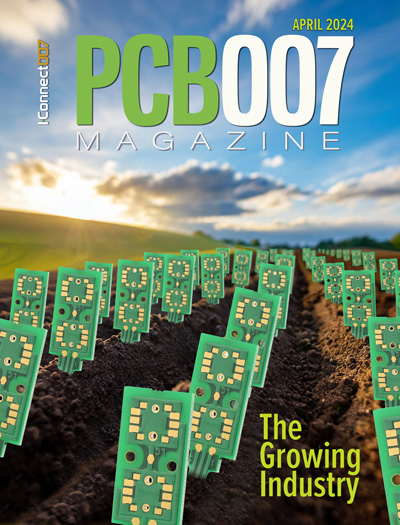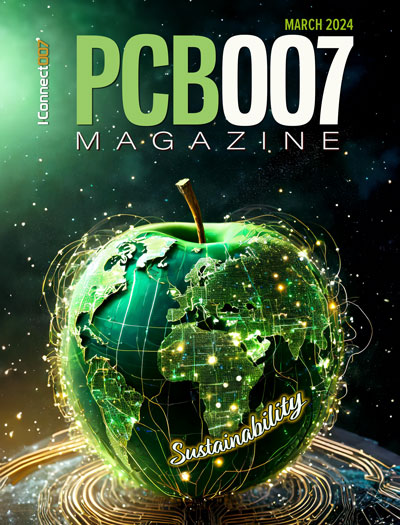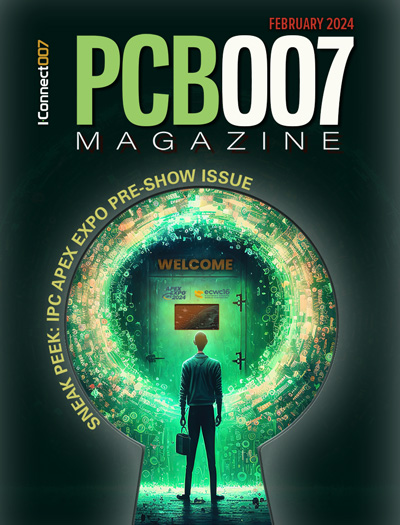-

- News
- Books
Featured Books
- pcb007 Magazine
Latest Issues
Current Issue
The Growing Industry
In this issue of PCB007 Magazine, we talk with leading economic experts, advocacy specialists in Washington, D.C., and PCB company leadership to get a well-rounded picture of what’s happening in the industry today. Don’t miss it.

The Sustainability Issue
Sustainability is one of the most widely used terms in business today, especially for electronics and manufacturing but what does it mean to you? We explore the environmental, business, and economic impacts.

The Fabricator’s Guide to IPC APEX EXPO
This issue previews many of the important events taking place at this year's show and highlights some changes and opportunities. So, buckle up. We are counting down to IPC APEX EXPO 2024.
- Articles
- Columns
Search Console
- Links
- Events
||| MENU - pcb007 Magazine
A New Source for Laser Drills
June 10, 2015 | Barry Matties, I-Connect007Estimated reading time: 15 minutes
When I recently visited the West Coast offices of Nano System Inc. I caught up with Sam Sekine, formerly of Hitachi. Nano System is a new company focused on producing and selling laser drill systems to the PCB industry. In this interview, Mr. Sekine discusses his staff, the company’s technology, and Nano System’s strategy for the future.
Barry Matties: Sam, start by telling us a little bit about the team at Nano System Inc.
Sam Sekine: All the people currently working for Nano System used to work for Hitachi. As a result, our staff has a lot of experience with the circuit board industry—they are in R&D, design, and sales and marketing—so we field a very strong team based on these experienced people.
Matties: Is Nano System primarily focused on laser drilling equipment?
Sekine: Basically, but it’s not necessarily just laser drilling, it’s laser processing of other types of materials. We have our R&D department back in New Hampshire and these are the guys developing the laser equipment. Our office here in Milpitas is more sales and marketing, as well as R&D and application development.
In the past, our focus has always been on the circuit board. Circuit board manufacturers are still the main potential customer base, but we do have some applications in semiconductor and consumables, so those are new areas for us. Our core business is providing state-of-the-art laser equipment for the PCB and other industries.
Matties: Did Nano System acquire the Hitachi brand?
Sekine: No, it has nothing to do with Hitachi. I established Nano System as its own company. We are a totally separate company from Hitachi.
Matties: As far as you coming back into the marketplace, how is that process going? I've watched other companies struggle to gain traction, like Interdyne, for example. I went to their facility and met Mr. Kosmowski and saw his flying wing design. They had several nice-looking pieces of equipment built, but they ran out of the horsepower needed to make it. How is this process going for you? You're coming up against some strong competitors out there.
Sekine: I see the big challenge. I do know Mr. Kosmowski; he’s a very nice man and a leader in the industry. When we first started, of course, we had no machines, no demo machines, no customers, no nothing. That's a big challenge! That was last year.
Luckily, the people who believed in us in the past said, "Okay, if you say you can make the machines, I will believe you." We presented drawings, specifications, and our team, and we got the first laser machine order last year, which we are delivering next week. We really appreciate the commitment from our customers. They used to be our Hitachi customers.
Those are the people believing in us, and they haven’t even seen the machine—just drawings on paper. It's not like they’re low-cost machines either; it's an expensive machine.
Matties: Do you have any that are currently on order from a circuit board fabricator?
Sekine: Yes, we were fortunate to receive orders already. One company ordered our own laser machine and another PCB fabricator already placed an order for a mechanical drilling machine that is not our brand, but made by Tongtai, a Taiwanese company. We represent Tongtai as the sole distributor in the United States and Canada. Both companies said that, because we are handling and can support Hitachi machines, they also felt comfortable buying machines from us. The Tongtai machine will be customized by Nano System staff after arriving in the U.S., to meet specific customer application.
We have also sold a couple of Tongtai machines to Asian customers. It is kind of like having a relationship with a partner. We already have shipped those two machines, one in Chengdu and one in Shenzhen. We have recently been working with a big company on a large project for Tongtai. I cannot share much yet, but we’re working with 100–200 machines. Because we started as a laser equipment manufacturer, beginning with design and then manufacturing supporting those applications, that is our main business. However, with these Tongtai machines it is as a distributor.
Matties: So they are building their equipment, and it's their brand, but you are distributing it. Is their equipment laser as well?
Sekine: Their equipment is mechanical drills and routers, but ours is laser.
Matties: How will you handle sales in Asia for your brand?
Sekine: At this moment, we are just working with one U.S. customer. However, because of our relationship with Tongtai, when we get to that level and volume we will have a lot of support. Our partner also has a huge facility in Asia and many locations that they can support. Eventually, when we need to make large volumes we are planning to make the major portion of important parts here in the U.S. Then they can just make the commonly available base parts in Asia and we can integrate those two together. That is our plan.
Matties: You don’t have any orders for that yet?
Sekine: Actually, we received an order from Nova Drilling as well as a few other requests from PCB customers and customers in other industries. Everybody feels very comfortable with our capabilities to support them or develop customized equipment to meet their specific process needs.
Matties: Nova Drilling is right here in Santa Clara.
Sekine: I’ve been talking with Nova Drilling because I'm the one that sold the UV, CO2 and mechanical drills to the PCB industry in the U.S., and they said, "Well, if you can make a UV/CO2 combo, then we’ll want to buy your machine." I said, "I haven’t even made one machine yet." But they know the dimensions and which laser head will work well. They are the experts regarding the optics. We are expecting to ship in maybe three months.
Matties: Where are you in value proposition? I’m guessing your prices are all equal, but performance and speed are probably the big issues?
Sekine: Exactly: speed and quality. At the beginning, a lot of people had problems with quality—the hole shape, the diameter, or the positioning accuracy, with the biggest problem being the hole shape. Can they make a really good shape in order to make good plating? Some of them can, but for many it's difficult. So in order to make quality holes they’re dependent not only on the laser head itself, but also on optics, utilizing those lenses or mirrors. All these are important to make better holes, which is our expertise. Once we can show what kind of a hole we can make, I think that will have a big impact on the industry.
Matties: It is the credibility factor, and the longevity that is your big hurdle though, isn't it?
Sekine: I think so.
Matties: And that’s because you're new, and long-term service is the question. We know Excellon, ESI and others have been around for years. How do people find confidence in buying your products?
Page 1 of 3
Suggested Items
ZESTRON Welcomes Whitlock Associates as New Addition to their Existing Rep Team in Florida
04/19/2024 | ZESTRONZESTRON, the leading global provider of high-precision cleaning products, services, and training solutions in the electronics manufacturing and semiconductor industries, is thrilled to announce the addition of Whitlock Associates to its esteemed network of sales representatives.
Real Time with... IPC APEX EXPO 2024: AI Implementation at Omron
04/18/2024 | Real Time with...IPC APEX EXPOEditor Nolan Johnson and Omron Product Manager Nick Fieldhouse discuss the company's focus on AI implementation to enhance customer experience and results. They address programming challenges and how AI can help customers achieve better outcomes with less experience. Omron's AI is compatible with existing systems, facilitating easy upgrades.
Cadence Unveils Palladium Z3 and Protium X3 Systems
04/18/2024 | Cadence Design SystemsThe Palladium Z3 and Protium X3 systems offer increased capacity, and scale from job sizes of 16 million gates up to 48 billion gates, so the largest SoCs can be tested as a whole rather than just partial models, ensuring proper functionality and performance.
Ark Electronics Expands Global Manufacturing Factory Network in North America and Europe
04/17/2024 | PRNewswireElectronic Manufacturing Company Ark Electronics recently announced the expansion of its Global Factory Network with the addition of Electronics Manufacturing Service (EMS) capabilities in Mexico and Europe.
New Yorker, Geyer Electronic Sign New Distribution Agreement
04/16/2024 | New Yorker Electronics Co.New Yorker Electronics, global distributor of electronic components, recently announced a new franchised distribution agreement with Geyer Electronic. Geyer is an international manufacturer of Quart Crystals, Oscillators and Resonators.


